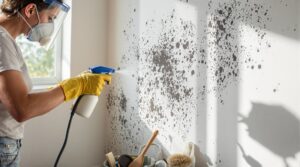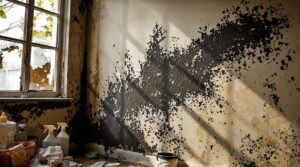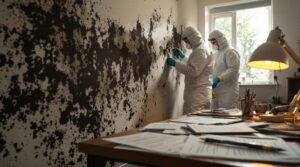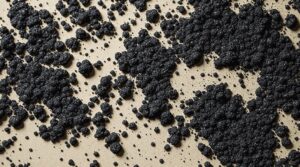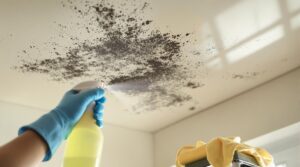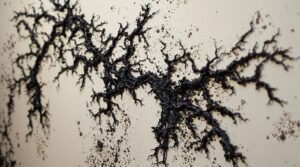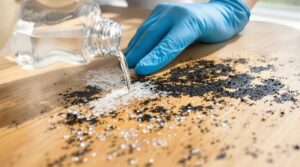Black mold removal requires a systematic approach that begins with identifying and addressing the underlying moisture source. Homeowners should inspect for visible moisture signs, assess humidity levels with a moisture meter, and address leaks and water damage immediately. Containing the mold infestation, testing for moisture and mold, and choosing the right cleaning solution are also essential steps. By understanding these key elements, individuals can effectively remove black mold and prevent future growth, ensuring a healthier and safer living environment.
Key Takeaways
- Identify and address underlying moisture sources, such as leaks and poor ventilation, to prevent further mold growth.
- Wear protective gear, seal off the area, and use ventilation to ensure safe mold removal and prevent spore dispersal.
- Use natural cleaning solutions like baking soda, vinegar, and water, or hydrogen peroxide to remove and clean black mold.
- Maintain indoor humidity levels below 50% and regularly inspect and clean areas prone to moisture to prevent future mold growth.
- Seek professional help for extensive mold infestations or if you have a compromised immune system, and consider consulting a public adjuster for insurance claims.
Finding and Fixing the Moisture Source
Before attempting to remove black mold, it is essential to identify and address the underlying moisture source that is fueling its growth. Common moisture sources include leaking faucets, damaged plumbing, and small leaks from water heaters, particularly in basements and bathrooms.
A thorough inspection of the affected area should be conducted to detect visible signs of moisture, and humidity levels should be assessed using a moisture meter test.
Addressing any leaks or water damage immediately is imperative to preventing further moisture accumulation. Ensuring proper ventilation in high-humidity areas, such as bathrooms and kitchens, is also essential. Exhaust fans should be used during cooking and showering to reduce moisture levels.
Additionally, hidden moisture sources behind walls or under flooring must be regularly checked and addressed, as these can harbor mold and remain undetected without proper investigation.
The average family generates 4 gallons of moisture daily through normal activities, making proper ventilation crucial for preventing mold growth.
Preparing for Safe Mold Removal
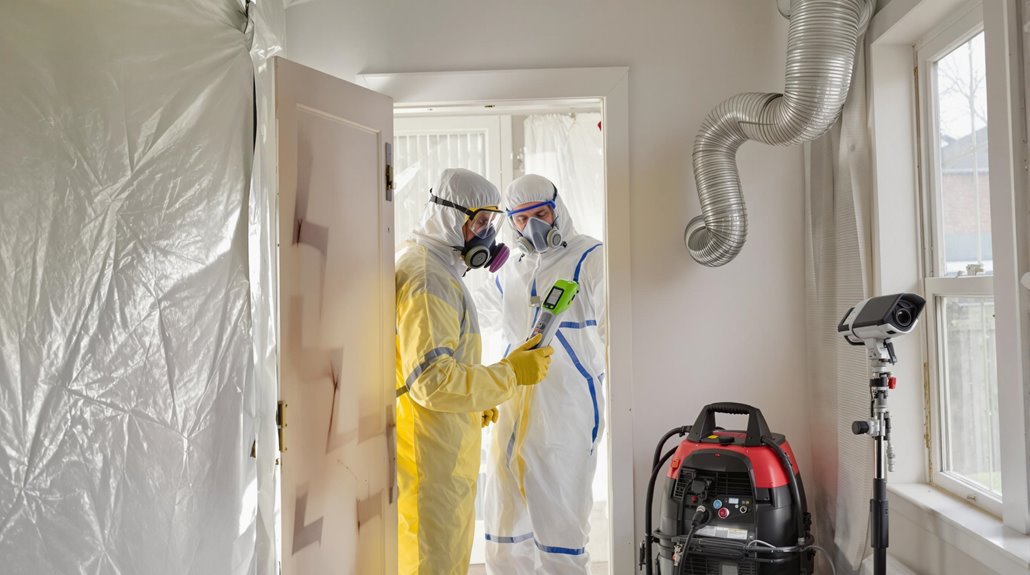
While ensuring safety is a significant aspect of any mold removal process, preparing the area and oneself properly is essential to minimize exposure to toxic mold spores.
Wearing protective gear, including a respirator, long-sleeved clothing, safety goggles, and rubber gloves, is important to preventing health risks.
To contain airborne spores and limit contamination, the area must be sealed off with heavy tarps and painter's tape. An exhaust fan should be positioned near an outdoor opening to expel airborne spores while maintaining adequate ventilation.
A moisture meter is used to assess the affected area's moisture levels, ensuring stable conditions to prevent further mold growth. Heating and air conditioning systems should be turned off to prevent spore dispersal.
HEPA air scrubbers are essential equipment for capturing airborne spores during the cleanup process.
By taking these precautions, individuals can safely proceed with the mold removal process, minimizing risks to their health and preventing further contamination.
Adequate preparation is key to successful mold remediation.
Containing the Mold Infestation
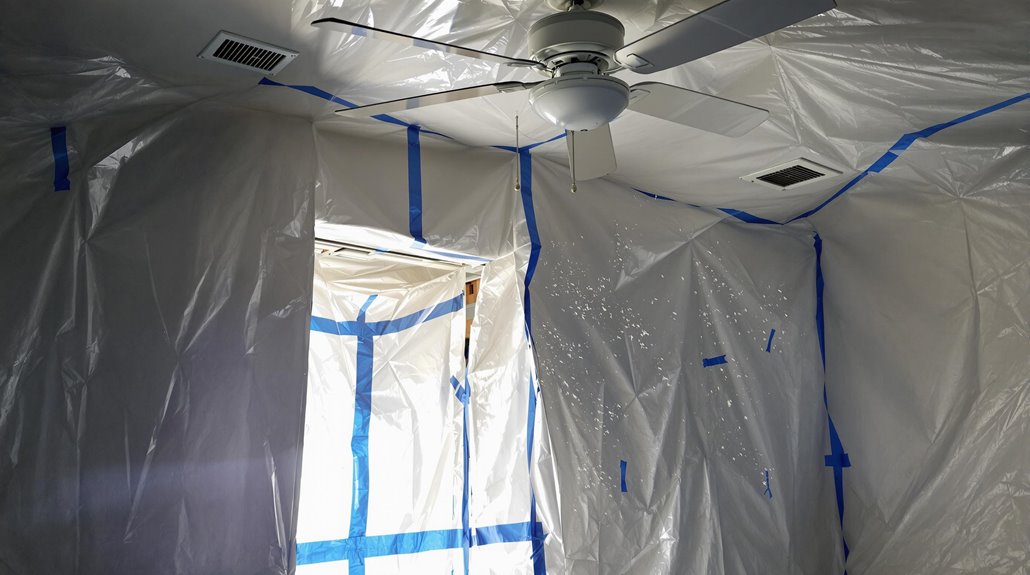
To effectively contain a mold infestation, it is essential to seal off affected areas from the rest of the home to prevent further spread of mold spores.
This involves blocking doorways and openings with heavy tarps and painter's tape, as well as turning off HVAC systems and fans to minimize air movement.
For areas between 10-100 square feet, professional containment protocols and specialized expertise are required to ensure proper remediation.
Seal Off Affected Areas
As the first step in containing a mold infestation, sealing off the affected areas is essential to prevent the spread of mold spores to other parts of the home.
To effectively contain the mold, several measures must be taken.
- Seal doorways and vents with heavy tarps and painter's tape to prevent spores from spreading.
- Turn off the heating or air conditioning system to minimize air movement and reduce the chance of mold spores becoming airborne.
- Utilize proper ventilation by opening windows and doors, while ensuring that sealed areas remain isolated from unaffected spaces.
Using double-layered barriers and decontamination chambers provides the most secure containment for serious mold remediation projects.
Prevent Spore Spread
Preventing spore spread is essential during mold removal, because even slight air movements can disperse spores throughout the home.
To minimize air movement, heating and air conditioning systems should be turned off. Doorways and vents are sealed with heavy tarps and painter's tape to contain mold spores within the affected area. An exhaust fan is positioned near outdoor openings to expel airborne spores and maintain airflow away from living areas.
Clutter is reduced to limit surfaces for spores to settle on. A moisture meter is used to confirm stable moisture levels before starting the cleanup process, as introducing water can release dormant spores.
Negative air pressure systems with HEPA filtration must maintain at least -5 Pascals to effectively contain airborne mold particles.
Isolate Infested Spaces
Effective containment of mold infestations relies heavily on the isolation of infested spaces. To prevent the spread of mold spores to other areas of the home, it is essential to seal doorways and openings with heavy tarps and painter's tape.
The following measures should be taken to isolate infested spaces:
- Seal doorways and openings to contain mold spores and prevent their spread
- Turn off heating or air conditioning systems to reduce air movement that could disperse spores throughout the house
- Clear the area of unnecessary items to facilitate thorough remediation and maintain proper ventilation
Maintaining negative air pressure of -5 Pascals within the containment area helps prevent contaminated air from escaping into clean spaces.
Testing for Moisture and Mold
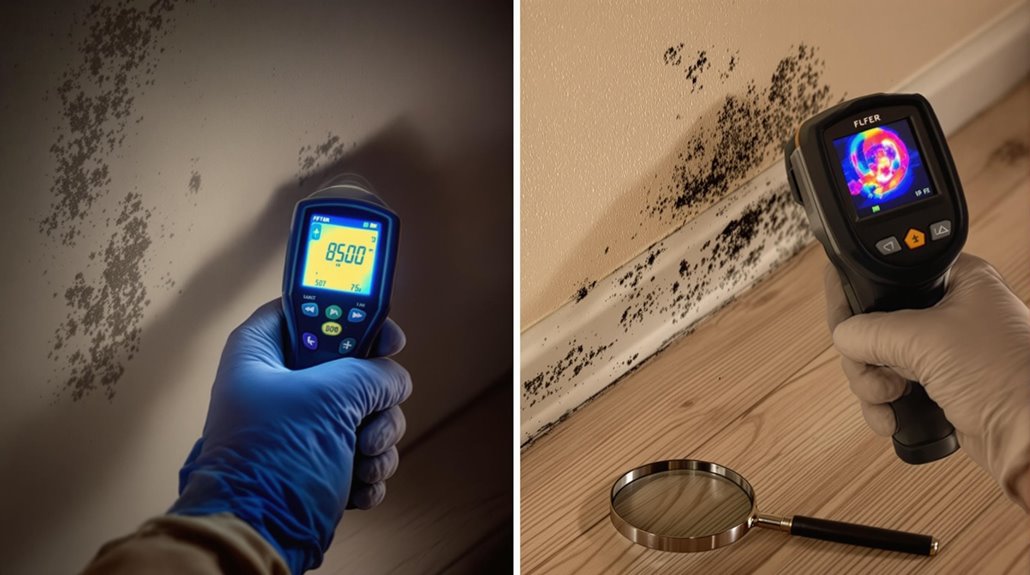
To accurately assess moisture levels in areas where mold is suspected, a moisture meter is employed to detect high moisture content, a primary factor for mold growth.
This assessment is vital in identifying areas that may harbor hidden mold, which can be further verified through visual inspections for signs of water damage.
The type of moisture meter used can greatly impact the accuracy of the assessment, and understanding the options available is essential for effective mold detection.
Thermal imaging cameras provide additional detection capabilities by revealing temperature variations that indicate moisture intrusion behind walls and under flooring.
Types of Moisture Meters
The process of testing for moisture and mold requires a thorough understanding of the various types of moisture meters available.
These devices help identify areas of high moisture levels, which can contribute to mold growth.
- Pin-Type Moisture Meters use metal probes to measure electrical resistance in materials, ideal for evaluating wood and drywall.
- Non-Invasive Moisture Meters utilize electromagnetic signals to detect moisture levels without damaging surfaces, beneficial for larger areas or delicate materials.
- Hygrometers measure relative humidity in the air, helping identify potential mold growth conditions when humidity levels exceed 50%.
It is essential to calibrate moisture meters according to the specific material being tested and consider a reading above 20% as high, prompting further investigation and remediation efforts to prevent mold growth.
Checking for Hidden Mold
While visible mold growth is often easy to identify, hidden mold can thrive in areas inaccessible to the naked eye, making it essential to employ specialized testing methods to detect its presence.
To inspect for hidden mold, a moisture meter is used to accurately assess moisture levels in suspected areas, as high moisture levels often indicate potential mold presence. Common moisture sources, such as leaking pipes and areas with poor ventilation, are inspected, particularly in basements and bathrooms.
Signs of mold growth are looked for on surfaces like drywall and behind appliances. If moisture is detected, the area is lightly sprayed with water to prevent spores from becoming airborne.
Documenting moisture readings and signs of mold helps with remediation planning and provides necessary information if professional help is required.
Identifying Water Damage Sources
Because moisture is a primary catalyst for black mold growth, identifying water damage sources is a crucial step in the remediation process.
Evaluating moisture levels in potential mold-affected areas can be done using a moisture meter, which provides accurate readings to identify problem areas.
Common moisture sources that lead to black mold growth include:
- Leaking faucets and damaged plumbing
- Water heaters with small leaks
- Hidden mold growth behind drywall or wallpaper due to water damage and moisture accumulation
Regularly checking for signs of water damage, such as discoloration on walls or ceilings, can help identify moisture sources before they lead to significant mold problems.
To prevent mold spores from becoming airborne during testing, lightly spray the area with water before conducting any evaluations.
Choosing the Right Cleaning Solution
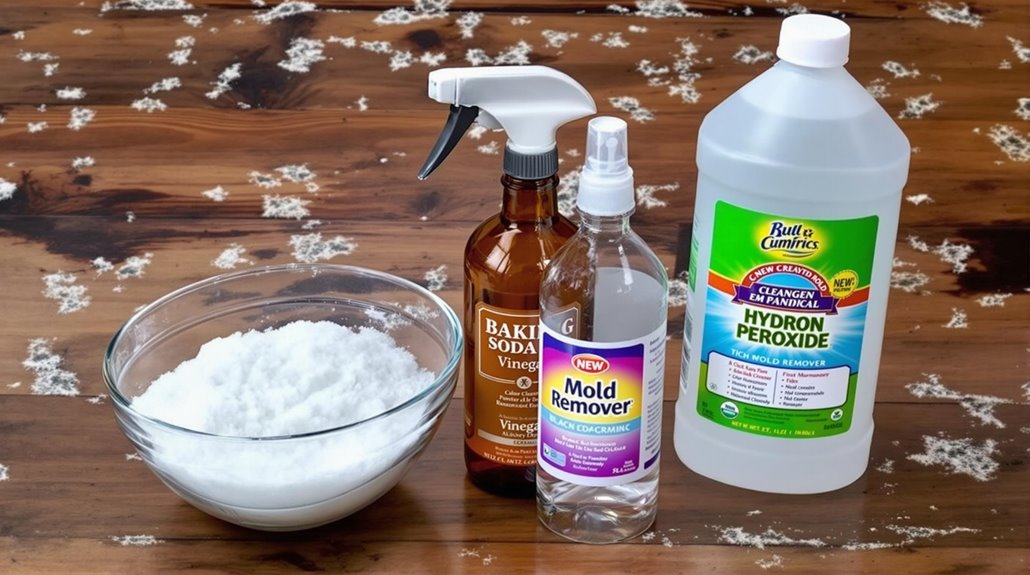
Selecting an effective cleaning solution is a crucial step in black mold removal. For a safe and effective cleaning, consider using a natural mixture of 1 part baking soda to 5 parts vinegar and 5 parts water. This solution is gentle on surfaces yet potent against mold growth.
For more stubborn mold, hydrogen peroxide at a concentration of 3% can be effective. However, it's important to test it first on a small, inconspicuous area to prevent discoloration.
Commercial mold removers often contain specialized biocides that can effectively kill mold spores. Always read the label for safety instructions and surface compatibility.
Vinegar is also a safe and effective option for killing mold on various surfaces, as it can reach the roots of the mold and prevent regrowth without using harsh chemicals.
Avoid using bleach on porous surfaces like wood and drywall, opting for products specifically designed for mold remediation instead.
Removing Black Mold From Walls and Ceilings
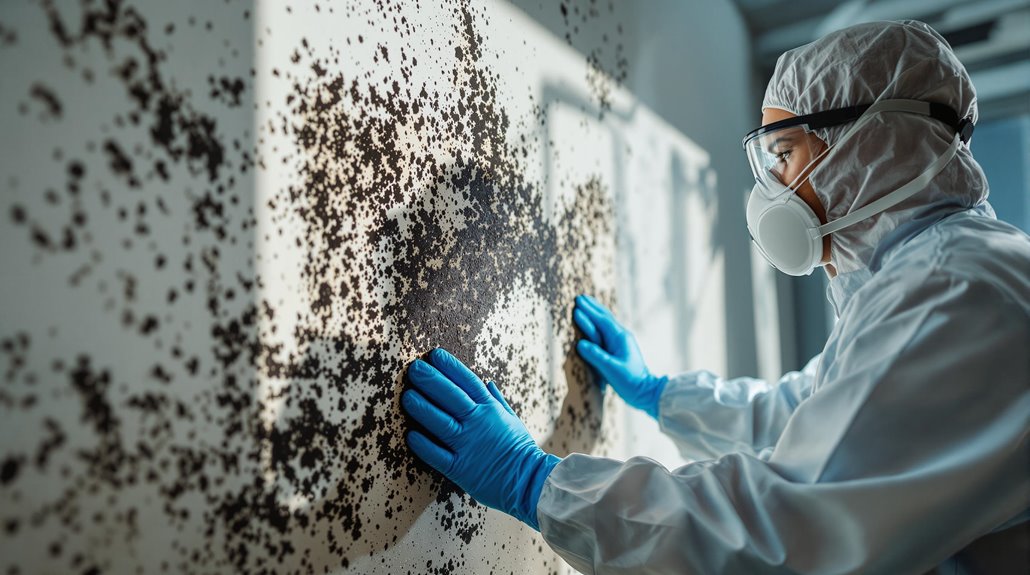
Removing black mold from walls and ceilings requires attention to safety and prevention to guarantee effective eradication and minimize the risk of future growth.
To begin, it is essential to identify and rectify the underlying moisture issue, as mold thrives in damp environments.
Proper protective gear, including gloves, goggles, and a respirator, must also be worn to safeguard against exposure to mold spores during the removal process.
Cleaning Black Mold Safely
When tackling black mold infestations on walls and ceilings, it is essential to prioritize safety to prevent exposure to toxic spores. Effective cleaning methods for removing black mold require careful consideration of the mold remediation process.
To guarantee safe removal, individuals should wear protective gear, including an N-95 respirator, rubber gloves, and safety goggles.
Some key considerations for safe mold removal include:
- Lightly misting the affected areas with water before cleaning to prevent mold spores from becoming airborne
- Using a natural cleaning solution, such as a mixture of baking soda, vinegar, and water, or a commercial mold remover specifically designed for walls and ceilings
- Ensuring good air quality and controlling moisture to prevent future mold growth after removal.
Preventing Future Mold Growth
Having safely removed black mold from walls and ceilings, attention must now be turned to preventing its return. To prevent future mold growth, maintaining indoor humidity levels below 50% through dehumidifiers and ventilation is essential. Inspection and repair of leaks, guaranteeing adequate sunlight, and using mold-resistant products in moisture-prone areas also inhibit mold growth.
| Prevention Methods | Description | Benefits |
|---|---|---|
| Maintain Humidity Levels | Use dehumidifiers and ventilation to keep humidity below 50% | Reduces moisture that fosters mold growth |
| Inspect and Repair Leaks | Fix plumbing, roof, and window leaks promptly | Prevents conditions conducive to mold growth |
| Guarantee Adequate Sunlight | Use light-colored paint to enhance light reflection | Inhibits mold growth in dark environments |
| Use Mold-Resistant Products | Utilize mold-resistant drywall and paint in moisture-prone areas | Inhibits mold growth from the start |
Cleaning and Disinfecting Surfaces
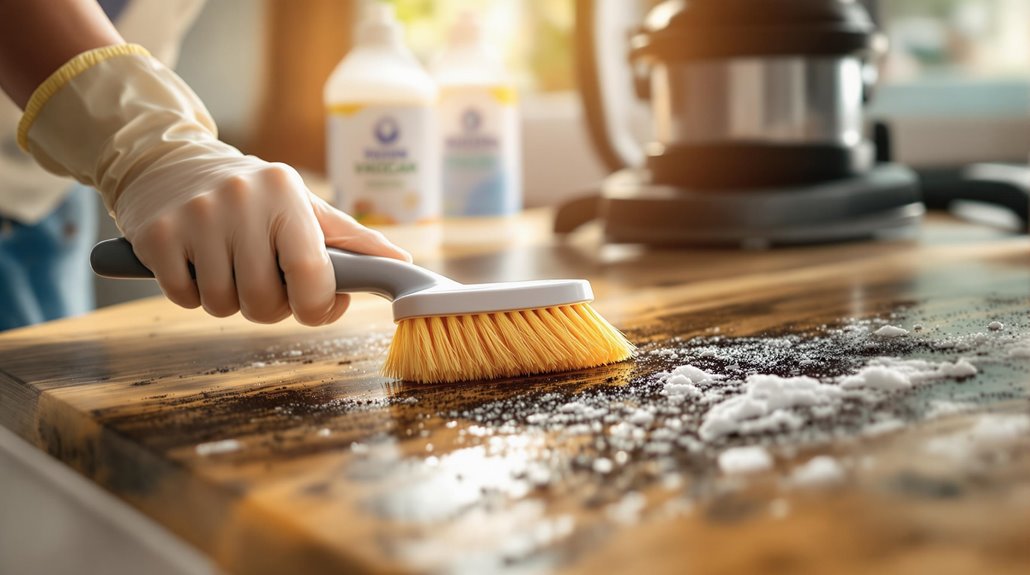
Prior to initiating the cleaning process, it is essential to select an effective cleaning solution suitable for the type of surface being treated and the severity of the mold growth. A solution of dish soap and warm water can be used for light mold, while vinegar or a borax solution may be necessary for more stubborn growths.
When cleaning and disinfecting surfaces, consider the following:
- Always test cleaning solutions on a small, inconspicuous area first to prevent discoloration or damage to surfaces.
- Utilize a vacuum with a HEPA filter to capture mold spores during cleanup, and dispose of the vacuumed material outdoors in a sealed plastic bag to prevent spore dispersal.
- Avoid using bleach on porous materials like wood or drywall, and instead opt for natural alternatives like hydrogen peroxide or tea tree oil.
Thorough cleaning and disinfecting of surfaces is vital to remove mold and prevent future growth.
Preventing Future Mold Growth
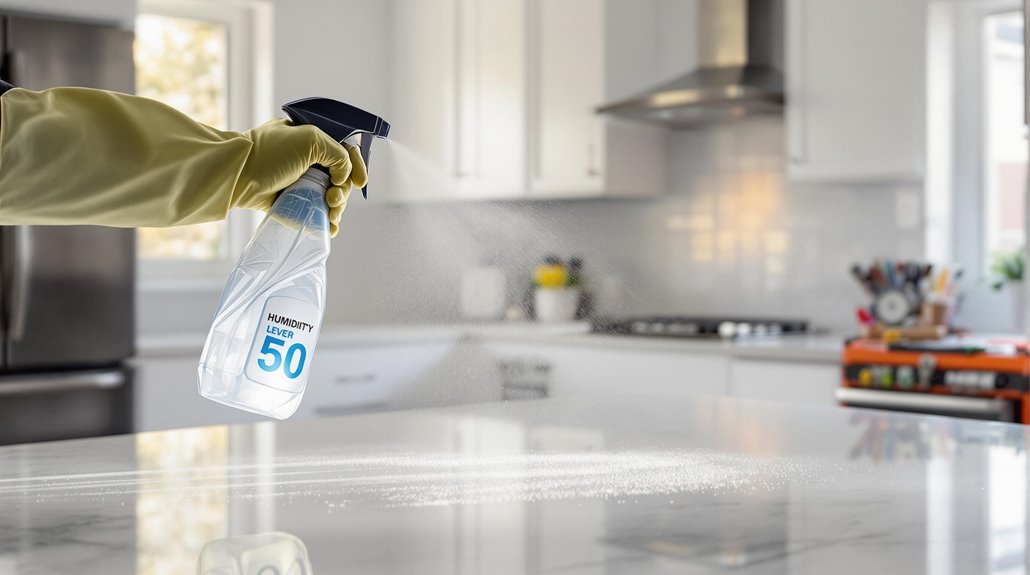
While thorough cleaning and disinfecting are essential in removing existing mold, preventing future growth is equally important to guarantee a mold-free environment. To prevent moisture accumulation, it is vital to reduce humidity levels, regularly inspect for leaks, and improve ventilation.
| Prevention Methods | Benefits | Implementation |
|---|---|---|
| Reduce humidity levels | Inhibits mold growth | Maintain indoor humidity below 50% |
| Regularly inspect and repair | Prevents moisture accumulation | Inspect plumbing, roofs, and windows for leaks |
| Improve ventilation | Reduces humidity levels | Utilize exhaust fans in kitchens and bathrooms |
Using mold-resistant products on building materials, such as wood and drywall, can also prevent fungal growth. Regularly cleaning and drying areas prone to moisture, like basements and attics, can deter mold spores from settling and proliferating. By implementing these measures, individuals can greatly reduce the risk of mold growth and maintain a healthier indoor environment.
When to Call a Professional Mold Remediation Service
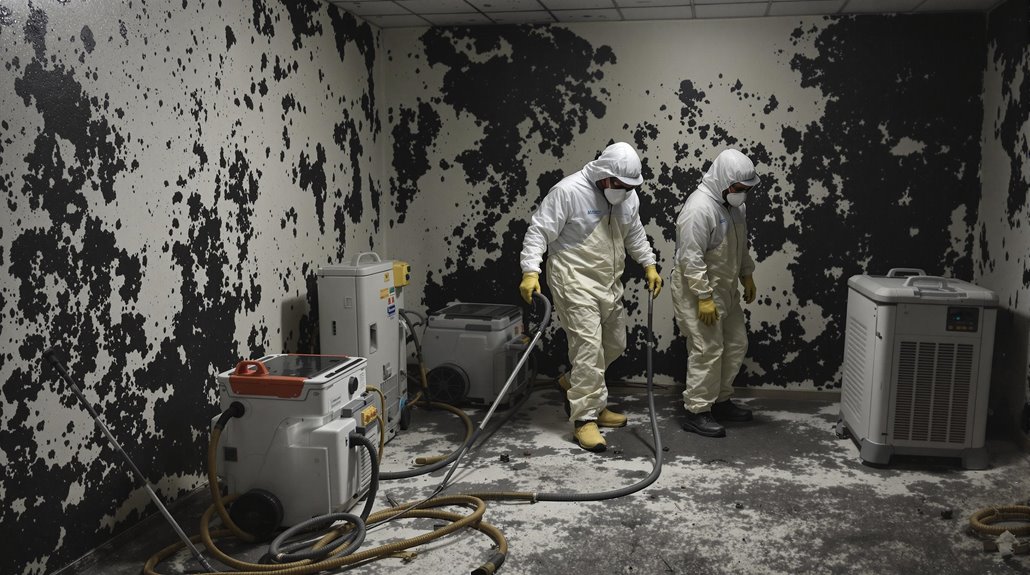
Despite the most diligent prevention efforts, mold growth can still occur, necessitating professional intervention. In certain situations, it is vital to seek the expertise of mold remediation services to guarantee thorough and safe removal.
The following scenarios warrant professional attention:
- Extensive mold infestations covering areas larger than 10 square feet require specialized equipment and techniques to prevent further growth and potential health effects.
- Individuals with compromised immune systems, respiratory conditions, or allergies should seek professional help to avert health complications associated with mold exposure.
- When mold is caused by extensive water damage, such as flooding or major leaks, professional remediation services are necessary to address underlying moisture issues and prevent mold regrowth.
Professional mold remediation services possess the necessary equipment and expertise to remove moisture, assess hidden areas, and provide extensive treatment options.
Their intervention is essential for preventing long-term damage and potential health risks associated with mold exposure.
Maintaining a Mold-Free Home Environment

To prevent mold growth and maintain a healthy indoor environment, it is essential to control the factors that contribute to its proliferation. High moisture is a primary contributor to mold growth, and keeping indoor humidity levels below 50% is vital.
| Method | Description | Benefits |
|---|---|---|
| Reduce Humidity | Use dehumidifiers in damp spaces | Prevents mold growth |
| Inspect Regularly | Check for leaks in moisture-prone areas | Reduces mold risk |
| Improve Ventilation | Utilize exhaust fans during cooking and showering | Minimizes humidity |
| Maintain Cleanliness | Regularly dust and clean areas where mold may grow | Eliminates potential mold spores |
| Control Moisture | Promptly repair water damage and remove standing water | Reduces mold risk |
The Benefits Of Consulting A Public Adjuster

When dealing with black mold removal, consulting a public adjuster can be a strategic decision for homeowners.
A public adjuster brings expertise in insurance claims, providing an objective damage assessment and streamlining the claim process to guarantee fair compensation for the damages incurred.
Expertise In Insurance Claims
How can homeowners effectively navigate the intricate process of insurance claims for black mold damage? Consulting a public adjuster can be a valuable step in ensuring fair compensation for losses.
With expertise in evaluating damage and understanding policy language, public adjusters increase the likelihood of claims being approved and maximize settlement amounts.
- They accurately document mold damage, including necessary repairs and remediation costs, providing a thorough report to support the claim.
- Public adjusters work on behalf of the policyholder, allowing homeowners to focus on recovery while negotiations with the insurance company are handled.
- Hiring a public adjuster can lead to a quicker resolution of claims, reducing time spent on insurance disputes and enabling faster restoration of the affected property by a mold remediation company.
Objective Damage Assessment
A thorough damage assessment is vital in determining the extent of black mold damage and subsequent insurance claims. Consulting a public adjuster facilitates an objective damage assessment, guaranteeing a detailed evaluation of the damage.
Public adjusters possess expertise in identifying hidden mold damage that may be overlooked by homeowners, preventing underestimation of repair costs. They advocate for the policyholder throughout the claims process, negotiating with insurance companies to secure a fair settlement for mold remediation and property restoration.
Streamlined Claim Process
What distinguishes a successful mold remediation effort from a prolonged and costly ordeal? A key factor is the involvement of a public adjuster.
By leveraging their expertise in maneuvering through complex insurance policies and paperwork, a public adjuster can greatly expedite the claims process.
Some benefits of consulting a public adjuster include:
- Thorough assessment of damages to guarantee accurate documentation and valuation for maximum compensation
- Expertise in maneuvering through complex insurance policies and paperwork to streamline the claims process
- Experience negotiating with insurance companies to secure more favorable settlements
Higher Claim Payouts & Settlements
Typically, homeowners who enlist the services of a public adjuster can expect markedly higher claim payouts compared to those who navigate the claims process alone. This is because public adjusters are skilled negotiators who understand the intricacies of insurance policies and can effectively advocate for their clients' rights.
Studies have shown that homeowners who hire public adjusters often receive settlements that are 20% to 50% higher than those who handle claims on their own. A public adjuster can guarantee that all relevant damages, including hidden mold growth and potential health risks, are thoroughly assessed and included in the claim, increasing the likelihood of complete compensation.
This allows homeowners to focus on mold remediation and recovery efforts, knowing they have a professional working to secure the best possible outcome.
About The Public Claims Adjusters Network (PCAN)
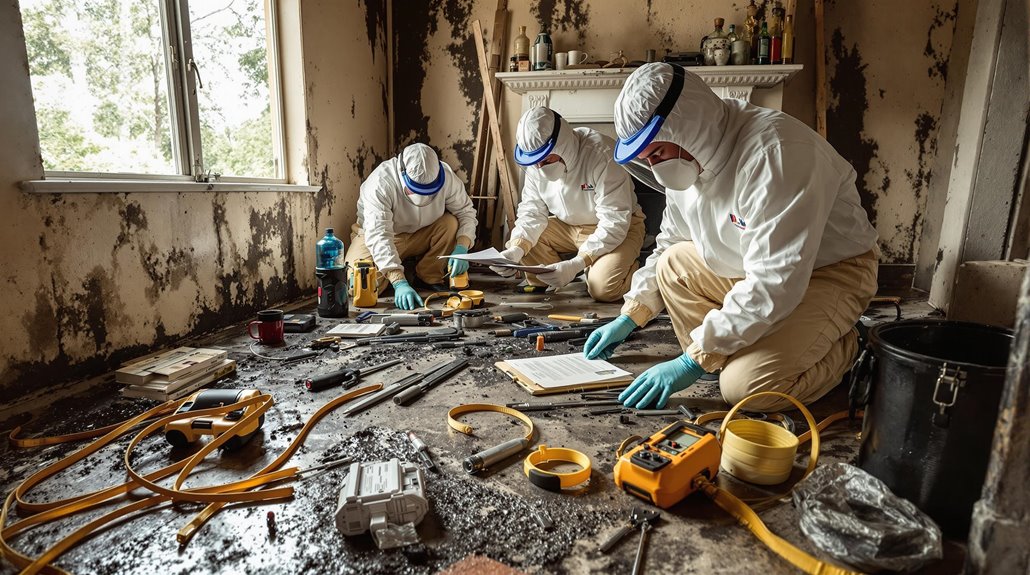
The Public Claims Adjusters Network (PCAN) operates as a nationwide organization of meticulously vetted and state-licensed public adjusters, providing specialized services in residential and commercial property damage insurance claims.
As a trusted resource for policyholders, PCAN connects clients with expert public adjusters who have undergone an intensive application and interview process to guarantee the highest standards of ethics, morals, and professionalism.
Key aspects of PCAN's operations include:
- Member adjusters are pre-vetted, verified, and licensed, with expertise in over 30 different claim types and a presence in 40+ states.
- PCAN enforces the highest standards of ethics and professionalism, with mandatory yearly audits of licenses and complaints.
- The network serves as a valuable resource for both policyholders and top public adjusters nationwide, facilitating connections and guaranteeing that clients receive expert assistance with their property damage insurance claims.
Frequently Asked Questions
Can I Safely Remove Black Mold Myself?
Individuals can safely remove black mold themselves if the affected area is small, utilizing DIY mold removal methods, safety precautions, and proper cleaning solutions, but mold identification, protective gear, and awareness of health risks are vital, otherwise, seek professional help.
What Is the Protocol for Black Mold Removal?
A painstaking archaeologist uncovers hidden dangers. Black mold removal protocol involves: identification techniques, safety precautions checklist, and removal equipment guide. Consider professional services for severe cases. Guarantee post-removal inspection, adopt prevention strategies, and be aware of health effects.
What Kills 100% of Black Mold?
Hydrogen peroxide (3% concentration) is an effective mold killer, eliminating 100% of black mold spores when applied directly and allowed to sit for at least 10 minutes, making it a reliable option among mold removal techniques.
Can a House With Black Mold Be Saved?
Over 70% of homes have mold growth, posing significant health risks. A house with black mold can be saved, but remediation costs can reach $10,000, impacting house value and property insurance, emphasizing the need for mold inspection and prevention strategies.
